Unit4 Don't eat in class Grammar Focus-3c课件(共22张PPT)
文档属性
| 名称 | Unit4 Don't eat in class Grammar Focus-3c课件(共22张PPT) | 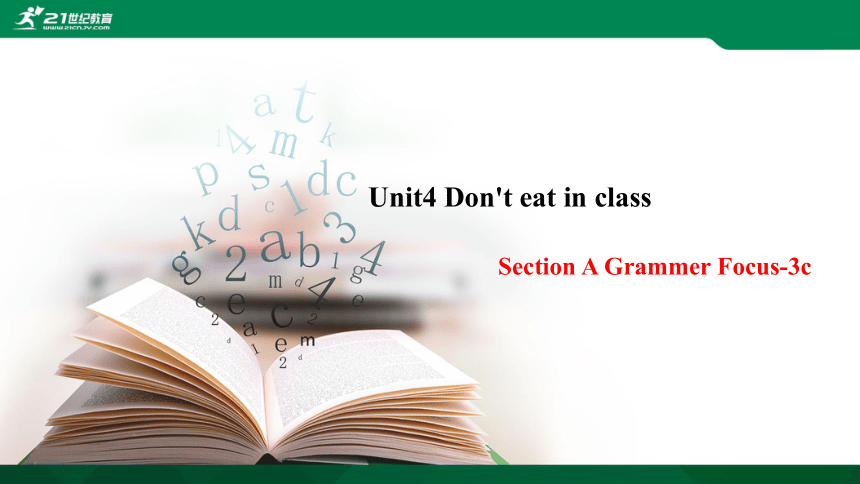 | |
| 格式 | zip | ||
| 文件大小 | 8.1MB | ||
| 资源类型 | 试卷 | ||
| 版本资源 | 人教新目标(Go for it)版 | ||
| 科目 | 英语 | ||
| 更新时间 | 2020-12-09 14:58:02 | ||
图片预览

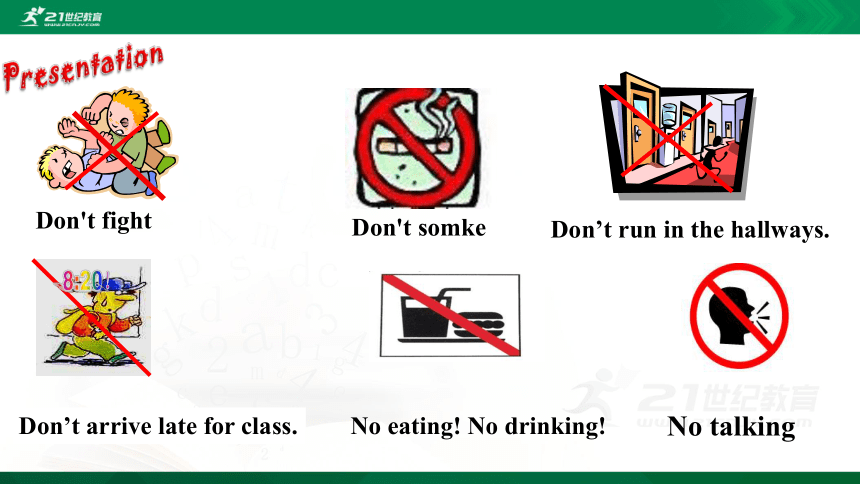
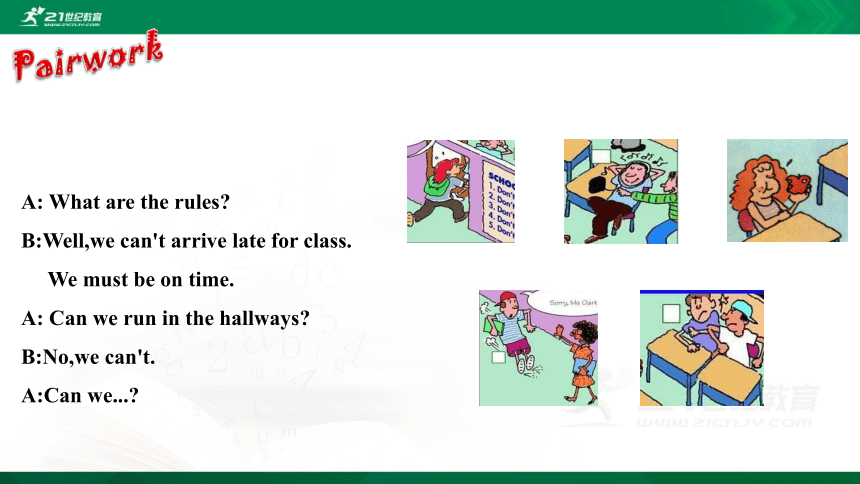
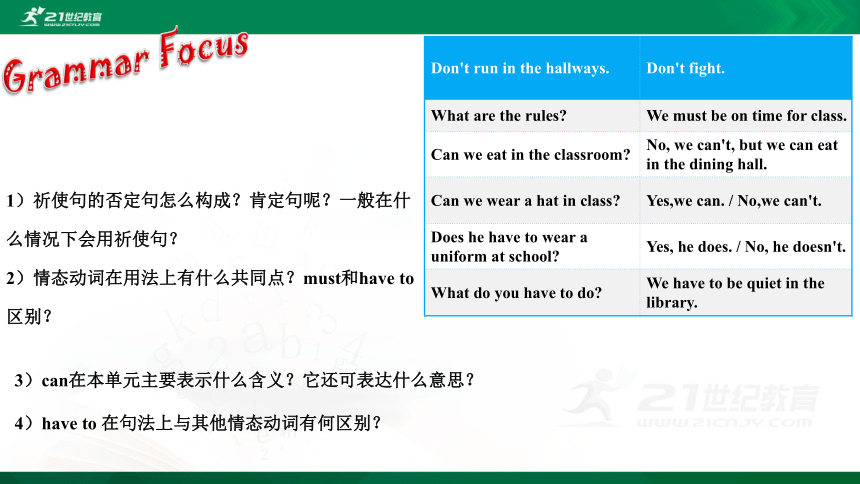
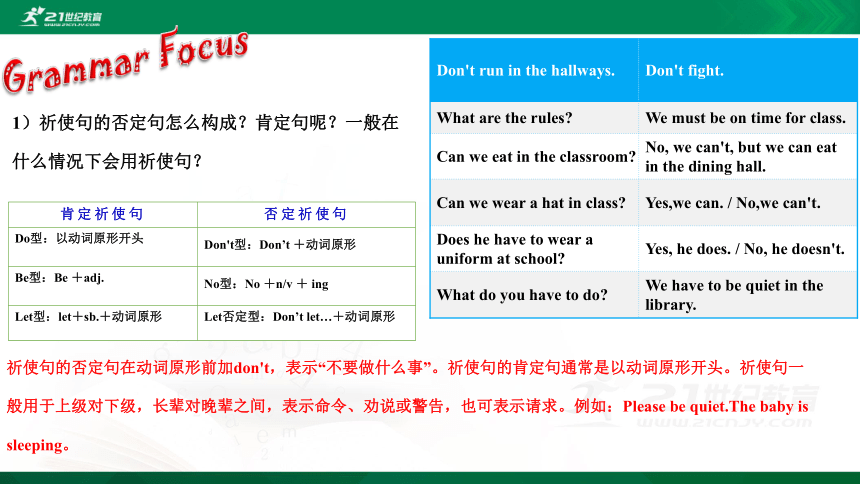
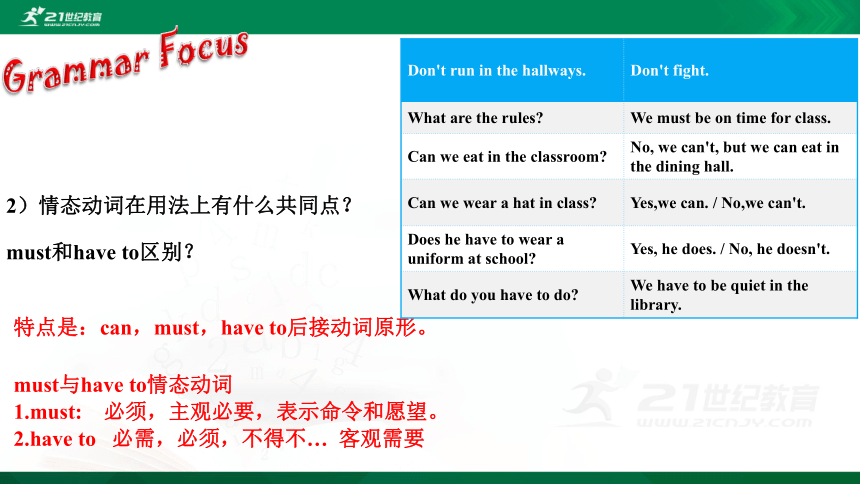
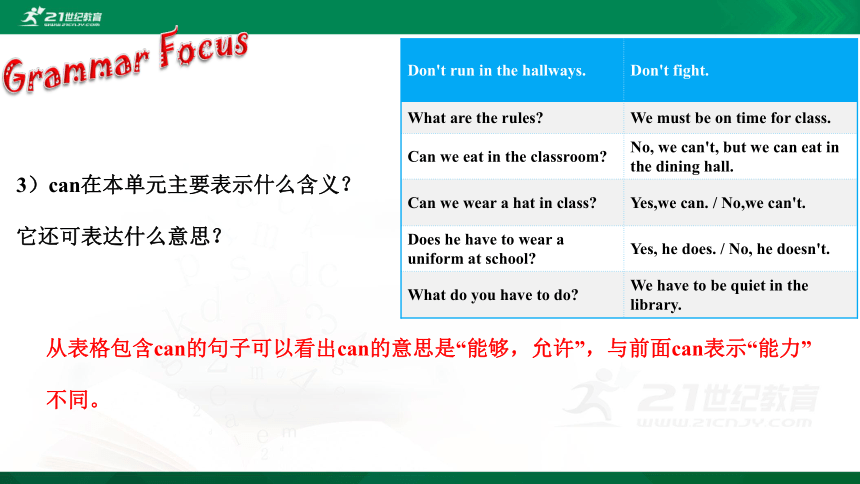
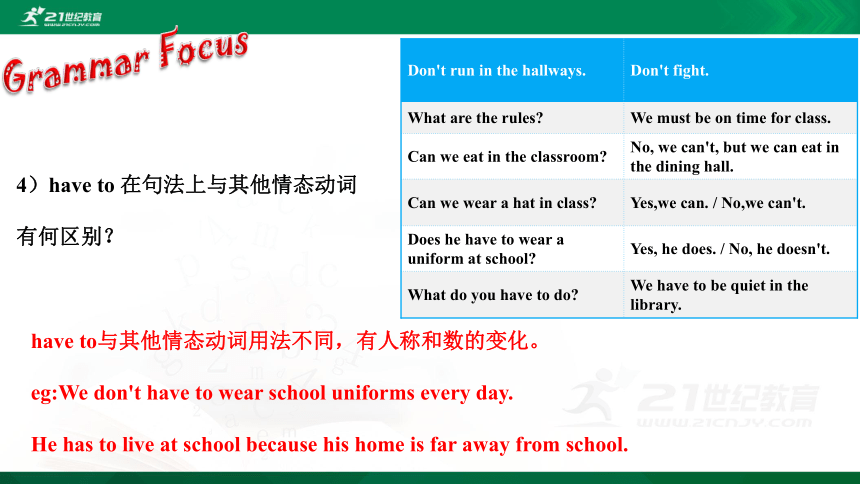
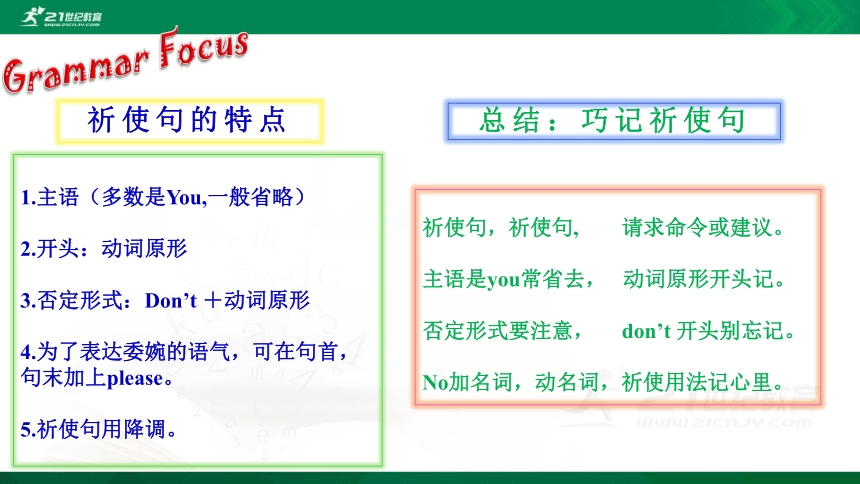
文档简介
(共22张PPT)
Unit4
Don't
eat
in
class
Section
A
Grammer
Focus-3c
No
talking
No
eating!
No
drinking!
Don't
fight
Don’t
arrive
late
for
class.
Don't
somke
Don’t
run
in
the
hallways.
8:20!
A:
What
are
the
rules?
B:Well,we
can't
arrive
late
for
class.
We
must
be
on
time.
A:
Can
we
run
in
the
hallways?
B:No,we
can't.
A:Can
we...?
1)祈使句的否定句怎么构成?肯定句呢?一般在什么情况下会用祈使句?
2)情态动词在用法上有什么共同点?must和have
to区别?
3)can在本单元主要表示什么含义?它还可表达什么意思?
4)have
to
在句法上与其他情态动词有何区别?
Don't
run
in
the
hallways.
Don't
fight.
What
are
the
rules?
We
must
be
on
time
for
class.
Can
we
eat
in
the
classroom?
No,
we
can't,
but
we
can
eat
in
the
dining
hall.
Can
we
wear
a
hat
in
class?
Yes,we
can.
/
No,we
can't.
Does
he
have
to
wear
a
uniform
at
school?
Yes,
he
does.
/
No,
he
doesn't.
What
do
you
have
to
do?
We
have
to
be
quiet
in
the
library.
1)祈使句的否定句怎么构成?肯定句呢?一般在什么情况下会用祈使句?
Don't
run
in
the
hallways.
Don't
fight.
What
are
the
rules?
We
must
be
on
time
for
class.
Can
we
eat
in
the
classroom?
No,
we
can't,
but
we
can
eat
in
the
dining
hall.
Can
we
wear
a
hat
in
class?
Yes,we
can.
/
No,we
can't.
Does
he
have
to
wear
a
uniform
at
school?
Yes,
he
does.
/
No,
he
doesn't.
What
do
you
have
to
do?
We
have
to
be
quiet
in
the
library.
祈使句的否定句在动词原形前加don't,表示“不要做什么事”。祈使句的肯定句通常是以动词原形开头。祈使句一般用于上级对下级,长辈对晚辈之间,表示命令、劝说或警告,也可表示请求。例如:Please
be
quiet.The
baby
is
sleeping。
肯定祈使句
否定祈使句
Do型:以动词原形开头
Don't型:Don’t
+动词原形
Be型:Be
+adj.
No型:No
+n/v
+
ing
Let型:let+sb.+动词原形
Let否定型:Don’t
let…+动词原形
2)情态动词在用法上有什么共同点?must和have
to区别?
特点是:can,must,have
to后接动词原形。
Don't
run
in
the
hallways.
Don't
fight.
What
are
the
rules?
We
must
be
on
time
for
class.
Can
we
eat
in
the
classroom?
No,
we
can't,
but
we
can
eat
in
the
dining
hall.
Can
we
wear
a
hat
in
class?
Yes,we
can.
/
No,we
can't.
Does
he
have
to
wear
a
uniform
at
school?
Yes,
he
does.
/
No,
he
doesn't.
What
do
you
have
to
do?
We
have
to
be
quiet
in
the
library.
must与have
to情态动词
1.must:
必须,主观必要,表示命令和愿望。
2.have
to
必需,必须,不得不…
客观需要
从表格包含can的句子可以看出can的意思是“能够,允许”,与前面can表示“能力”不同。
3)can在本单元主要表示什么含义?它还可表达什么意思?
Don't
run
in
the
hallways.
Don't
fight.
What
are
the
rules?
We
must
be
on
time
for
class.
Can
we
eat
in
the
classroom?
No,
we
can't,
but
we
can
eat
in
the
dining
hall.
Can
we
wear
a
hat
in
class?
Yes,we
can.
/
No,we
can't.
Does
he
have
to
wear
a
uniform
at
school?
Yes,
he
does.
/
No,
he
doesn't.
What
do
you
have
to
do?
We
have
to
be
quiet
in
the
library.
have
to与其他情态动词用法不同,有人称和数的变化。
eg:We
don't
have
to
wear
school
uniforms
every
day.
He
has
to
live
at
school
because
his
home
is
far
away
from
school.
4)have
to
在句法上与其他情态动词有何区别?
Don't
run
in
the
hallways.
Don't
fight.
What
are
the
rules?
We
must
be
on
time
for
class.
Can
we
eat
in
the
classroom?
No,
we
can't,
but
we
can
eat
in
the
dining
hall.
Can
we
wear
a
hat
in
class?
Yes,we
can.
/
No,we
can't.
Does
he
have
to
wear
a
uniform
at
school?
Yes,
he
does.
/
No,
he
doesn't.
What
do
you
have
to
do?
We
have
to
be
quiet
in
the
library.
祈使句的特点
1.主语(多数是You,一般省略)
2.开头:动词原形
3.否定形式:Don’t
+动词原形
4.为了表达委婉的语气,可在句首,句末加上please。
5.祈使句用降调。
总结:巧记祈使句
祈使句,祈使句,
请求命令或建议。
主语是you常省去,
动词原形开头记。
否定形式要注意,
don’t
开头别忘记。
No加名词,动名词,祈使用法记心里。
Make
a
short
dialogue
by
using
the
following
pictures.
A:Can
he
eat
in
class?
B:
No,
he
can’t.
A:
What
does
he
do
in
class?
B:
He
eats
something.
Don't
eat
in
class.
Make
a
short
dialogue
by
using
the
following
pictures.
A:
What
does
he
do
in
class?
B:
He
listens
to
music.
A:
Can
he
listen
to
music
in
class?
B:
No,
he
can’t.
Don’t
lisen
to
music
in
class.
Make
a
short
dialogue
by
using
the
following
pictures.
Don’t
arrive
late
for
class.
A:
What’s
wrong
with
him?
B:
He’s
late
for
class.
A:
Can
he
be/arrive
late
for
class?
B:
No,
he
can’t.
A:
Can
we...?
B:
Yes,.../No,...
8:20!
3a
Write
the
rules
for
the
school
library.
Library
Rules
Don’t
talk.
__________________
__________________
__________________
Don’t
eat
or
drink.
Don’t
listen
to
music.
Don’t
take
photos.
Library
Rules
No
talking.
__________________
__________________
__________________
No
eating
or
drinking.
No
music.
No
photos.
3b
Use
the
words
to
make
questions
about
the
rules.
Then
write
answers
according
to
your
school.
1.Be
quiet?
Q:
———————————————————————
(she/have
to
/in
the
library)
A:
———————————————————————
2.to/school/get
to/does/how
long/take/it
Q:
———————————————————————
(he/have
to/in
the
dinning
hall)
A:
———————————————————————
Does
she
have
to
be
quiet
in
the
library?
Does
he
have
to
eat
in
the
dining
hall?
Yes,
she
does.
Yes,
he
does.
3b
Use
the
words
to
make
questions
about
the
rules.
Then
write
answers
according
to
your
school.
3.Listen
to
music?
Q:
———————————————————————(we/can/in
the
hallways)
A:
———————————————————————
4.Wear
a
hat?
Q:
———————————————————————
(we/can/in
the
classroom)
A:
———————————————————————
Can
we
listen
to
music
in
the
hallways
Can
we
wear
a
hat
in
the
classroom?
No,we
can't.
No,we
can't.
3c
Make
up
five
cool
rules
for
your
dream
school.
Share
your
rules
with
the
class.
Your
classmates
vote
for
the
Coolest
School!
1.
We
can
eat
in
class.
2.
We
don’t
have
to
come
to
school
every
day.
3.
…
Dear
students,
In
order
to
have
a
good
environment
(环境),
we
should
have
some
rules
in
our
school.
Here
are
some
suggestions;
we
hope
that
all
of
us
can
have
a
look
at
them.
1.
Don’t
sleep
in
class.
2.
Clean
the
classroom
every
day.
3.
__________________________
4.
__________________________
5.
__________________________
6.
__________________________
Yours
____
假如你是学校的校长,你想制订哪些校规,
将其记录并尝试告诉校长你的想法。
Report
to
the
class.
(汇报采访结果)
At
my
dream
school,
we
don’t
have
to
come
to
school
every
day.
We
can
eat
in
the
classroom.We
can
listen
to
music
in
class.We
don’t
have
to
do
homework.We
don’t
have
to
wear
school
uniforms
at
school.
假如你是学校的校长,你想制订哪些校规,
将其记录并尝试告诉校长你的想法。
1.
Review
the
sentence
patterns
in
Grammar
Focus.
2.
Collect
much
more
signs
you
see
in
your
daily
life
and
try
to
describe
them
in
English.
谢谢
21世纪教育网(www.21cnjy.com)
中小学教育资源网站
有大把高质量资料?一线教师?一线教研员?
欢迎加入21世纪教育网教师合作团队!!月薪过万不是梦!!
详情请看:
https://www.21cnjy.com/help/help_extract.php
Unit4
Don't
eat
in
class
Section
A
Grammer
Focus-3c
No
talking
No
eating!
No
drinking!
Don't
fight
Don’t
arrive
late
for
class.
Don't
somke
Don’t
run
in
the
hallways.
8:20!
A:
What
are
the
rules?
B:Well,we
can't
arrive
late
for
class.
We
must
be
on
time.
A:
Can
we
run
in
the
hallways?
B:No,we
can't.
A:Can
we...?
1)祈使句的否定句怎么构成?肯定句呢?一般在什么情况下会用祈使句?
2)情态动词在用法上有什么共同点?must和have
to区别?
3)can在本单元主要表示什么含义?它还可表达什么意思?
4)have
to
在句法上与其他情态动词有何区别?
Don't
run
in
the
hallways.
Don't
fight.
What
are
the
rules?
We
must
be
on
time
for
class.
Can
we
eat
in
the
classroom?
No,
we
can't,
but
we
can
eat
in
the
dining
hall.
Can
we
wear
a
hat
in
class?
Yes,we
can.
/
No,we
can't.
Does
he
have
to
wear
a
uniform
at
school?
Yes,
he
does.
/
No,
he
doesn't.
What
do
you
have
to
do?
We
have
to
be
quiet
in
the
library.
1)祈使句的否定句怎么构成?肯定句呢?一般在什么情况下会用祈使句?
Don't
run
in
the
hallways.
Don't
fight.
What
are
the
rules?
We
must
be
on
time
for
class.
Can
we
eat
in
the
classroom?
No,
we
can't,
but
we
can
eat
in
the
dining
hall.
Can
we
wear
a
hat
in
class?
Yes,we
can.
/
No,we
can't.
Does
he
have
to
wear
a
uniform
at
school?
Yes,
he
does.
/
No,
he
doesn't.
What
do
you
have
to
do?
We
have
to
be
quiet
in
the
library.
祈使句的否定句在动词原形前加don't,表示“不要做什么事”。祈使句的肯定句通常是以动词原形开头。祈使句一般用于上级对下级,长辈对晚辈之间,表示命令、劝说或警告,也可表示请求。例如:Please
be
quiet.The
baby
is
sleeping。
肯定祈使句
否定祈使句
Do型:以动词原形开头
Don't型:Don’t
+动词原形
Be型:Be
+adj.
No型:No
+n/v
+
ing
Let型:let+sb.+动词原形
Let否定型:Don’t
let…+动词原形
2)情态动词在用法上有什么共同点?must和have
to区别?
特点是:can,must,have
to后接动词原形。
Don't
run
in
the
hallways.
Don't
fight.
What
are
the
rules?
We
must
be
on
time
for
class.
Can
we
eat
in
the
classroom?
No,
we
can't,
but
we
can
eat
in
the
dining
hall.
Can
we
wear
a
hat
in
class?
Yes,we
can.
/
No,we
can't.
Does
he
have
to
wear
a
uniform
at
school?
Yes,
he
does.
/
No,
he
doesn't.
What
do
you
have
to
do?
We
have
to
be
quiet
in
the
library.
must与have
to情态动词
1.must:
必须,主观必要,表示命令和愿望。
2.have
to
必需,必须,不得不…
客观需要
从表格包含can的句子可以看出can的意思是“能够,允许”,与前面can表示“能力”不同。
3)can在本单元主要表示什么含义?它还可表达什么意思?
Don't
run
in
the
hallways.
Don't
fight.
What
are
the
rules?
We
must
be
on
time
for
class.
Can
we
eat
in
the
classroom?
No,
we
can't,
but
we
can
eat
in
the
dining
hall.
Can
we
wear
a
hat
in
class?
Yes,we
can.
/
No,we
can't.
Does
he
have
to
wear
a
uniform
at
school?
Yes,
he
does.
/
No,
he
doesn't.
What
do
you
have
to
do?
We
have
to
be
quiet
in
the
library.
have
to与其他情态动词用法不同,有人称和数的变化。
eg:We
don't
have
to
wear
school
uniforms
every
day.
He
has
to
live
at
school
because
his
home
is
far
away
from
school.
4)have
to
在句法上与其他情态动词有何区别?
Don't
run
in
the
hallways.
Don't
fight.
What
are
the
rules?
We
must
be
on
time
for
class.
Can
we
eat
in
the
classroom?
No,
we
can't,
but
we
can
eat
in
the
dining
hall.
Can
we
wear
a
hat
in
class?
Yes,we
can.
/
No,we
can't.
Does
he
have
to
wear
a
uniform
at
school?
Yes,
he
does.
/
No,
he
doesn't.
What
do
you
have
to
do?
We
have
to
be
quiet
in
the
library.
祈使句的特点
1.主语(多数是You,一般省略)
2.开头:动词原形
3.否定形式:Don’t
+动词原形
4.为了表达委婉的语气,可在句首,句末加上please。
5.祈使句用降调。
总结:巧记祈使句
祈使句,祈使句,
请求命令或建议。
主语是you常省去,
动词原形开头记。
否定形式要注意,
don’t
开头别忘记。
No加名词,动名词,祈使用法记心里。
Make
a
short
dialogue
by
using
the
following
pictures.
A:Can
he
eat
in
class?
B:
No,
he
can’t.
A:
What
does
he
do
in
class?
B:
He
eats
something.
Don't
eat
in
class.
Make
a
short
dialogue
by
using
the
following
pictures.
A:
What
does
he
do
in
class?
B:
He
listens
to
music.
A:
Can
he
listen
to
music
in
class?
B:
No,
he
can’t.
Don’t
lisen
to
music
in
class.
Make
a
short
dialogue
by
using
the
following
pictures.
Don’t
arrive
late
for
class.
A:
What’s
wrong
with
him?
B:
He’s
late
for
class.
A:
Can
he
be/arrive
late
for
class?
B:
No,
he
can’t.
A:
Can
we...?
B:
Yes,.../No,...
8:20!
3a
Write
the
rules
for
the
school
library.
Library
Rules
Don’t
talk.
__________________
__________________
__________________
Don’t
eat
or
drink.
Don’t
listen
to
music.
Don’t
take
photos.
Library
Rules
No
talking.
__________________
__________________
__________________
No
eating
or
drinking.
No
music.
No
photos.
3b
Use
the
words
to
make
questions
about
the
rules.
Then
write
answers
according
to
your
school.
1.Be
quiet?
Q:
———————————————————————
(she/have
to
/in
the
library)
A:
———————————————————————
2.to/school/get
to/does/how
long/take/it
Q:
———————————————————————
(he/have
to/in
the
dinning
hall)
A:
———————————————————————
Does
she
have
to
be
quiet
in
the
library?
Does
he
have
to
eat
in
the
dining
hall?
Yes,
she
does.
Yes,
he
does.
3b
Use
the
words
to
make
questions
about
the
rules.
Then
write
answers
according
to
your
school.
3.Listen
to
music?
Q:
———————————————————————(we/can/in
the
hallways)
A:
———————————————————————
4.Wear
a
hat?
Q:
———————————————————————
(we/can/in
the
classroom)
A:
———————————————————————
Can
we
listen
to
music
in
the
hallways
Can
we
wear
a
hat
in
the
classroom?
No,we
can't.
No,we
can't.
3c
Make
up
five
cool
rules
for
your
dream
school.
Share
your
rules
with
the
class.
Your
classmates
vote
for
the
Coolest
School!
1.
We
can
eat
in
class.
2.
We
don’t
have
to
come
to
school
every
day.
3.
…
Dear
students,
In
order
to
have
a
good
environment
(环境),
we
should
have
some
rules
in
our
school.
Here
are
some
suggestions;
we
hope
that
all
of
us
can
have
a
look
at
them.
1.
Don’t
sleep
in
class.
2.
Clean
the
classroom
every
day.
3.
__________________________
4.
__________________________
5.
__________________________
6.
__________________________
Yours
____
假如你是学校的校长,你想制订哪些校规,
将其记录并尝试告诉校长你的想法。
Report
to
the
class.
(汇报采访结果)
At
my
dream
school,
we
don’t
have
to
come
to
school
every
day.
We
can
eat
in
the
classroom.We
can
listen
to
music
in
class.We
don’t
have
to
do
homework.We
don’t
have
to
wear
school
uniforms
at
school.
假如你是学校的校长,你想制订哪些校规,
将其记录并尝试告诉校长你的想法。
1.
Review
the
sentence
patterns
in
Grammar
Focus.
2.
Collect
much
more
signs
you
see
in
your
daily
life
and
try
to
describe
them
in
English.
谢谢
21世纪教育网(www.21cnjy.com)
中小学教育资源网站
有大把高质量资料?一线教师?一线教研员?
欢迎加入21世纪教育网教师合作团队!!月薪过万不是梦!!
详情请看:
https://www.21cnjy.com/help/help_extract.php
同课章节目录
- Unit 1 Can you play the guitar?
- Section A
- Section B
- Unit 2 What time do you go to school?
- Section A
- Section B
- Unit 3 How do you get to school?
- Section A
- Section B
- Unit 4 Don't eat in class.
- Section A
- Section B
- Unit 5 Why do you like pandas?
- Section A
- Section B
- Unit 6 I'm watching TV.
- Section A
- Section B
- Review of Units 1-6
- Unit 7 It's raining!
- Section A
- Section B
- Unit 8 Is there a post office near here?
- Section A
- Section B
- Unit 9 What does he look like?
- Section A
- Section B
- Unit 10 I'd like some noodles.
- Section A
- Section B
- Unit 11 How was your school trip?
- Section A
- Section B
- Unit 12 What did you do last weekend?
- Section A
- Section B
